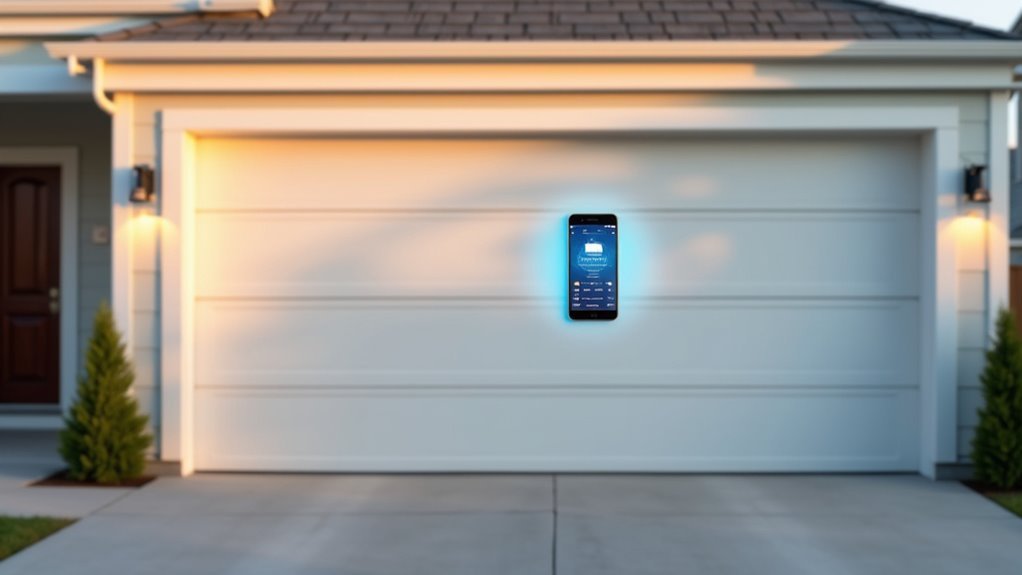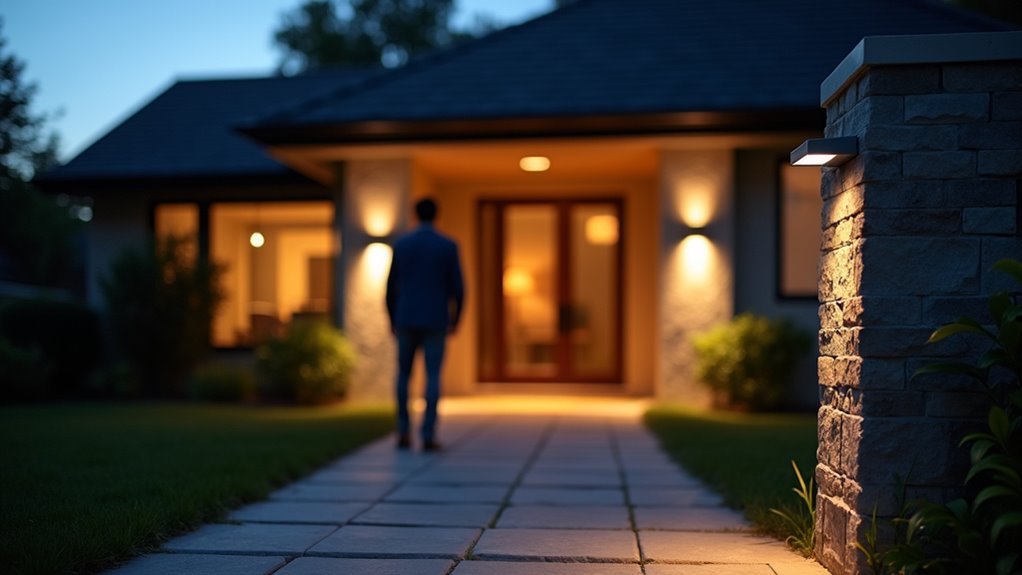You’re probably tired of manually opening your garage door or wondering if someone forgot to close it after leaving home. Your existing garage door doesn’t need a complete overhaul to join the smart home revolution. With the right upgrades, you can transform that basic opener into a connected powerhouse that responds to your smartphone, integrates with your security system, and even knows when you’re coming home. The question isn’t whether you can make it smart—it’s which approach will work best for your specific setup.
Understanding Smart Garage Door Technology

When you’re looking to modernize your garage without a complete overhaul, smart garage door technology offers the perfect solution. You can transform your existing setup by adding a smart garage door opener that works with your current system, as long as it was manufactured after 1993 and has standard safety sensors.
This technology lets you control your garage door remotely through smartphone apps, giving you unprecedented convenience and security.
You’ll enjoy features like geofencing, which automatically opens your door when you arrive home, and programmable auto-closing for peace of mind. The system integrates seamlessly with home automation platforms, allowing voice control through Alexa or Google Assistant.
You’ll also receive detailed activity logs and instant notifications about door usage, keeping you informed about who’s accessing your garage.
Evaluating Your Current Garage Door System
Before you invest in smart garage door technology, you’ll need to examine your current setup to determine compatibility and potential upgrade requirements.
Start by checking your existing garage door opener’s manufacturing date. If it’s pre-1993, you’ll likely need complete replacement since these older models can’t integrate with modern smart technology. Newer units can often accommodate upgrades.
Verify that standard safety sensors are installed, as they’re essential for smart hub compatibility like Chamberlain myQ systems.
Address any malfunctioning components, including faulty buttons or poor beam detection, before proceeding with upgrades.
Confirm strong Wi-Fi coverage reaches your garage for reliable connectivity.
Finally, match your opener’s horsepower rating with your door’s weight to guarantee peak performance after smart technology integration.
Choose Between Replacement or Retrofit Options

Once you’ve assessed your current garage door system, you’ll face an essential decision: replacing the entire opener or retrofitting your existing setup with smart technology.
If your opener was manufactured in 1993 or earlier, replacement is your best bet since these models lack compatibility with modern smart features. Installation typically takes 2-4 hours.
However, if you have a post-1993 opener with standard safety sensors, retrofit options offer an excellent alternative. Smart hubs like the Nexx NGX-200 controller can transform your system in just two minutes, connecting directly to your smartphone for remote operation.
Modern garage door openers with safety sensors can be instantly upgraded using smart retrofit controllers for seamless smartphone connectivity.
Both retrofit options and replacements cost between $40-$120, making upgrades affordable.
You’ll gain valuable automation features like geofencing and automatic closing regardless of your choice.
Smart Hub Installation for Existing Openers
Smart hub installation transforms your existing garage door opener into a connected device without replacing the entire system.
You’ll need an opener manufactured after 1993 with standard safety sensors for compatibility. The Chamberlain myQ Smart Garage Hub costs around $38.99, making it a budget-friendly upgrade.
Installation involves logging into the app, setting up the hub, and attaching door sensors. You’ll need a strong Wi-Fi signal for effective operation.
Once installed, you can remotely control your garage door through smartphone apps, enhancing convenience and security while tracking usage through activity logs.
The hub integrates seamlessly with smart home automation systems, allowing voice control through Alexa and Google Assistant for complete hands-free operation.
DIY Wi-Fi Switch Integration

While commercial smart hubs offer convenience, DIY Wi-Fi switch integration provides a more customizable and cost-effective solution at around $30.
You can transform your dumb garage door opener into a smart system without replacing the entire unit. The installation involves straightforward low-voltage wiring on a 12-volt system, eliminating safety concerns associated with high-voltage electrical work.
You’ll use the eLink app to pair with your Wi-Fi switch, enabling smartphone control from anywhere. Adding a monitoring device like Roost provides real-time status logging, which proves valuable for insurance documentation.
This approach preserves your existing manual buttons, so you’ll maintain traditional operation while gaining smart functionality. The DIY solution delivers professional results without the premium price tag.
Essential Tools and Equipment Needed
Before tackling your DIY Wi-Fi switch installation, you’ll need the right tools to guarantee a smooth setup process. A flathead screwdriver is vital for securing connections and components during installation.
Wire strippers will prepare wire ends for proper connections within your smart device setup. Don’t forget a multimeter to test electrical connections and confirm voltage levels are appropriate for your garage door opener.
Since Wi-Fi switches require strong wireless signals, you might need a Wi-Fi extender if your garage has weak connectivity. These essential tools form the foundation of your installation kit.
A reliable Wi-Fi signal is crucial for smart switch functionality, so consider installing an extender in areas with poor connectivity.
Additionally, gather adhesive tape for mounting smart devices and any required screws or anchors for securing components to your opener. Having everything ready beforehand prevents installation delays and guarantees professional results.
Step-by-Step Installation Process
Five simple steps will transform your standard garage door into a smart, Wi-Fi-enabled system.
First, gather your flathead screwdriver, wire strippers, and multimeter. These tools will make your smart garage controller installation straightforward and efficient.
- Secure the device – Use adhesive tape to attach your smart garage controller unit directly to your existing garage door opener. This eliminates the need for additional mounting hardware while ensuring stable placement.
- Connect the wiring – Insert just two wires into your garage door opener’s existing ports, following the manufacturer’s specific instructions for proper connections.
- Download the app – Install the corresponding smartphone app, like Nexx, to enable remote operation and configure advanced features.
- Test functionality – Remotely open and close your garage door through the app to verify successful installation.
Wiring Connections and Safety Considerations
Since wiring connections form the foundation of your smart garage door system, you’ll need to prioritize both precision and safety throughout this vital phase.
Precision and safety must be your top priorities when establishing the wiring foundation of your smart garage door system.
You can utilize existing ports without unplugging or rewiring your garage door opener, which simplifies installation considerably. Use a flathead screwdriver to secure connections and wire strippers to prepare wires for proper insertion.
Before starting, confirm your opener operates on low voltage—typically around 12 volts—to avoid high voltage hazards. Turn off the power supply and use a multimeter to test for voltage as essential safety measures.
Maintain clean, organized wiring connections to prevent interference and connectivity issues. This systematic approach guarantees your smart garage door system functions reliably while maintaining ideal safety standards throughout the installation process.
Mobile App Setup and Configuration
Three essential steps will transform your smart garage door controller into a fully functional remote system.
You’ll need to download the myQ app from either the Apple App Store or Google Play Store, then create your account.
Make sure your smartphone connects to a strong Wi-Fi network since your controller requires internet connectivity for remote access.
Follow these configuration steps:
- Download and install the myQ app from your device’s app store
- Connect your smartphone to a reliable Wi-Fi network for peak performance
- Follow in-app pairing instructions to link the controller with your garage door opener
- Enable geofencing features for automatic door operation based on your location proximity
Remember to check regularly for app updates to maintain functionality and access new features.
Testing Remote Control Functionality
Once you’ve completed the app setup, it’s time to check that everything works correctly before relying on your smart garage door system.
Start by testing the basic open and close functions through your smartphone app while standing near your garage. The Nexx NGX-200 works seamlessly with existing garage door openers, so you shouldn’t experience any compatibility issues.
Next, test the geofencing feature by walking to your specified distance boundary and confirming the door opens automatically.
Don’t forget to check the auto-close timer function by adjusting the duration settings and monitoring the door’s behavior.
Finally, test voice commands through Alexa or Google Assistant to verify hands-free operation works properly.
These tests confirm your system’s reliability.
Adding Door Status Monitoring Devices
You can enhance your garage’s security by installing door status monitoring devices that track whether your door is open or closed.
These sensors offer multiple installation approaches, from simple adhesive mounting to more permanent wired connections, and they’ll send real-time alerts directly to your smartphone.
When choosing a device, you’ll need to decide between battery-powered units for easy installation or wired options that provide continuous power without maintenance concerns.
Sensor Installation Methods
When installing door status monitoring devices, proper sensor placement becomes the foundation for reliable garage door tracking. These sensor installation methods guarantee accurate detection every time your garage door opens or closes.
Follow these essential steps for peak performance:
- Position the main sensor directly on your garage door panel, typically near the top section where movement is most consistent.
- Mount the base unit on your door frame or adjacent wall, maintaining the manufacturer’s recommended distance for reliable communication.
- Test the connection range before finalizing placement to verify your Wi-Fi signal reaches the installation area effectively.
- Verify battery accessibility so you can easily replace power sources without removing the entire unit.
After installation, use your mobile app to confirm accurate status reporting.
Real-Time Status Alerts
After completing your sensor setup, real-time status alerts transform your garage door into a connected security checkpoint that keeps you informed wherever you go.
Devices like the Roost or Nexx NGX-200 connect to your Wi-Fi network and send instant notifications to your smartphone whenever your garage door opens or closes. You’ll receive these real-time status alerts whether you’re at work, on vacation, or anywhere with internet access.
These monitoring systems integrate seamlessly with smart home platforms, allowing you to receive updates through Alexa or Google Assistant.
The constant tracking provides valuable security documentation for insurance purposes while giving you peace of mind. You’ll always know your garage door’s status, helping prevent security breaches and ensuring your home stays protected around the clock.
Battery Vs Wired Options
While selecting the perfect door monitoring device, understanding the fundamental differences between battery-powered and wired options will determine your installation experience and long-term satisfaction.
Battery-operated monitoring devices offer unmatched placement flexibility since you won’t need electrical outlets nearby. However, wired systems provide superior reliability and eliminate battery maintenance concerns entirely.
Consider these key factors when choosing:
- Installation complexity – Battery devices require minimal setup, while wired options need cable routing.
- Maintenance requirements – Battery systems need periodic replacements despite low-battery alerts.
- Performance reliability – Wired connections offer consistent operation without power interruptions.
- Security features – Wired devices typically integrate better with existing security systems.
Your garage’s layout, convenience preferences, and installation capabilities should guide your decision between these monitoring technologies.
Smart Home Integration Options
You can enhance your smart garage door’s functionality by connecting it to popular voice assistants like Alexa and Google Assistant for hands-free operation.
IFTTT (If This Then That) automation takes integration further by letting you create custom triggers and actions that sync your garage door with other smart devices in your home.
These connections transform your garage door from a standalone device into an integral part of your home’s automated ecosystem.
Voice Assistant Compatibility
Most modern homeowners expect their garage doors to integrate seamlessly with voice assistants like Alexa and Google Assistant. The Nexx NGX-200 smart garage controller delivers exceptional voice assistant compatibility, transforming your existing garage door into a hands-free convenience system.
This integration offers several key benefits:
- Hands-free operation – Open or close your garage door using simple voice commands from anywhere in your home.
- Geofencing automation – Set up proximity-based triggers that work with voice assistants to automatically operate your door.
- Easy upgrade path – Transform older garage systems without requiring complete opener replacement.
- Enhanced home automation – Manage multiple smart devices seamlessly throughout your connected home ecosystem.
Voice assistant compatibility elevates your garage door from basic functionality to sophisticated smart home integration.
IFTTT Automation Setup
Beyond voice commands, IFTTT (If This Then That) automation opens advanced smart home integration possibilities for your garage door system.
You’ll create automated actions between your garage door opener and other smart devices, enabling seamless home management. Setting up triggers is straightforward—automatically close your door when leaving home or receive notifications when it opens unexpectedly.
IFTTT offers pre-made applets for quick setup, or you can create custom automation tailored to your specific needs. The platform connects your garage door with various smart home systems, creating personalized workflows that enhance convenience and security.
While basic features are available, certain advanced functions require a $1 monthly subscription. This small investment reveals enhanced automation capabilities, making your garage door integration more sophisticated and responsive to your daily routines.
Troubleshooting Common Installation Issues
While installing a high-tech garage door system can transform your home’s convenience and security, installation hiccups often arise that’ll test your patience and problem-solving skills.
High-tech garage door installations promise convenience but often deliver frustrating challenges that demand patience and creative problem-solving skills.
Most problems with smart garage doors stem from basic connectivity and compatibility issues.
Here’s how to tackle the most common challenges:
- Check Wi-Fi strength – Weak signals in your garage area will cause remote operation failures and connectivity drops.
- Verify compatibility – Garage door openers manufactured before 1993 typically won’t support modern smart controllers.
- Double-check wiring – Improper connections during installation lead to unresponsive operations and system malfunctions.
- Restart everything – When apps or devices act up, reboot your smartphone and smart controller to resolve temporary glitches.
Always guarantee proper app setup and device pairing before troubleshooting hardware issues.
Maximizing Your Smart Garage Door Benefits
Once you’ve successfully installed your smart garage door system, you’ll want to take full advantage of its advanced capabilities.
Remote access control transforms how you interact with your garage, letting you operate the door from anywhere while receiving real-time notifications about activity.
Smart home integration amplifies these benefits by connecting your garage door to voice assistants and other automated systems throughout your house.
Remote Access Control
Remote access control transforms your garage into a smart entry point that responds to your commands from virtually anywhere.
You’ll gain unprecedented convenience through your smartphone app, eliminating the frustration of forgotten remotes or fumbling for keys.
Here are four key benefits of remote access control:
- Instant operation – Open or close your garage door from any location with internet connectivity
- Geofencing automation – Your door automatically opens as you approach home, streamlining your arrival
- Voice command integration – Control your garage hands-free through Alexa or Google Assistant
- Real-time monitoring – Receive instant notifications and track all door activity through detailed usage logs
The Nexx NGX-200 delivers these advanced features while working seamlessly with your existing opener through a simple two-wire installation.
Smart Home Integration
When you integrate your smart garage door with your home automation ecosystem, you’ll access a level of convenience that extends far beyond simple remote operation.
Voice commands through Alexa and Google Assistant let you operate your door hands-free, while geofencing technology automatically opens or closes it based on your proximity to home.
Smart home integration eliminates the need for separate remotes, streamlining your garage access through devices like the Nexx NGX-200 controller.
You’ll receive real-time notifications and track door activity through user-friendly smartphone apps compatible with both iOS and Android.
This integration enhances security by monitoring unauthorized access while creating seamless automation that responds to your daily routines without manual intervention.
Frequently Asked Questions
Can I Make My Existing Garage Door Smart?
You can make your existing garage door smart using devices like Nexx NGX-200 or Chamberlain myQ Smart Garage Hub. These controllers install easily with adhesive tape, requiring no electrical experience while adding smartphone control.
Should I Replace a 30 Year Old Garage Door?
You should replace your 30-year-old garage door. It lacks modern safety features, won’t support smart technology, and operates inefficiently. A new door offers better security, energy savings, and smart home integration capabilities.
Can I Convert My Old Garage Door Opener to Wi-Fi?
You can convert your old garage door opener to Wi-Fi using smart controllers like the Nexx NGX-200. These devices require no electrical experience and install in minutes using adhesive tape and simple wire connections.
How Much Does It Cost to Convert a Garage Door to Automatic?
You’ll spend between $40 to $120 for smart garage door openers, plus up to $39 for smart hubs. DIY Wi-Fi switches cost around $30, making automatic conversion affordable and budget-friendly.





Leave a Reply